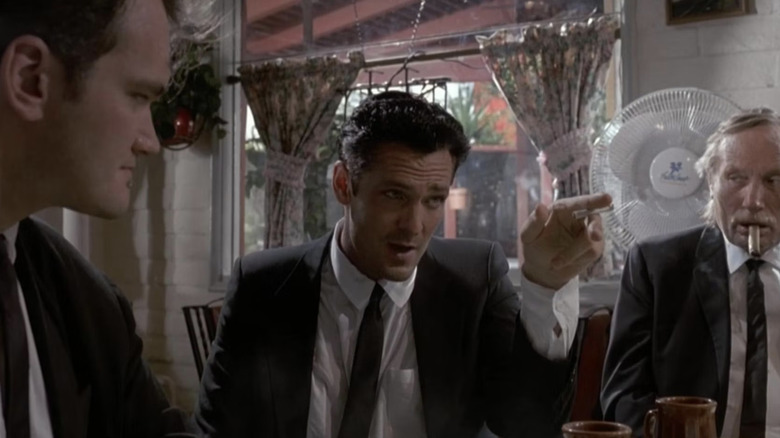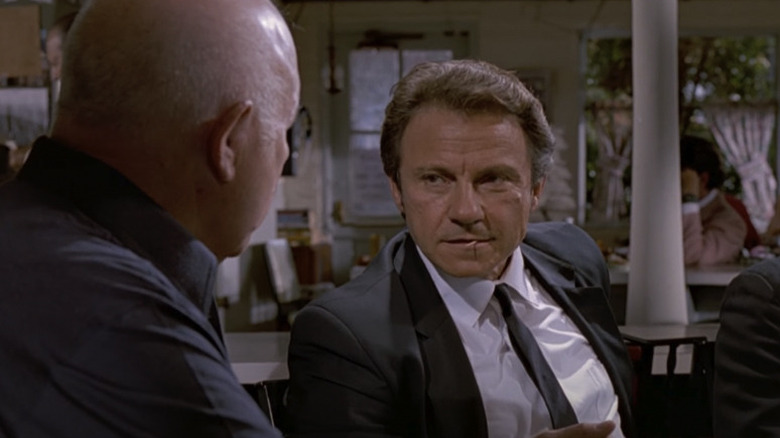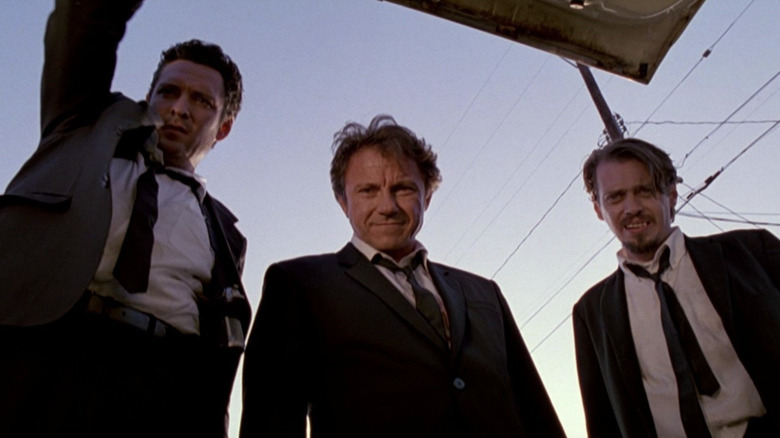Reservoir Dogs' Opening Diner Scene Was A Pain For Quentin Tarantino To Shoot
Quentin Tarantino's directorial debut "Reservoir Dogs" helped set expectations for what would come in future Tarantino movies: Long-winded conversations, excessive and bloody violence, non-linear storytelling, and of course, inspired music choices. The story of six criminals and their botched robbery made for a wildly compelling film. The small scale of "Reservoir Dogs" could be seen as limiting, but Tarantino took the small budget he had to work with and gave audiences a different kind of heist film. The film never shows the actual heist as it happens, but instead offers audiences a look at everything leading up to and after the theft, which inevitably goes wrong.
The writer/director knew the chemistry between the cast of "Reservoir Dogs" would make or break such an endeavor in storytelling. Thankfully, the anonymous criminals, who all go by color-coded aliases, were portrayed by talents such as Harvey Keitel, Michael Madsen, Tim Roth, and Steve Buscemi. Even Tarantino himself got in on the action as one of the criminals, playing Mr. Brown. The opening scene best exemplifies the entertaining and hilarious dynamic between the criminals — even though Quentin Tarantino found it challenging to shoot.
'The camera's just doing its own independent thing'
In a 1994 interview with Film Comment Magazine, Quentin Tarantino spoke about the process of filming the diner scene of "Reservoir Dogs." Specifically, he spoke about how the camera movement is some of the most notable of the entire movie:
"[The diner scene] has one of the most pronounced camera moves in the whole movie, that slow-moving 360 where people get lost, and then you find them again. But while I've got this big camera thing happening — and believe me, it was a big pain in the ass to shoot that — at the same time, the camera is just catching whoever it happens to catch at the time."
The difficult camera work is an interesting contrast to the mundane happenings at the diner table. The meandering nature of the camera almost mimics the flow of the conversation, easing you into this world and setting the metaphorical table, only so Tarantino can yank the tablecloth off later when the heist goes wrong. He explained that he was aiming to make the opening scene feel naturalistic while also showing the dynamic between this group of strangers before their big heist:
"It's not choreographed so that it's on Mr. Orange, and it hits Mr. Pink as he says his line and then finds itself on Mr. Blonde as he says his line — no, it's not doing that at all, people are talking offscreen, and the camera's just doing its own independent thing."
Camera shots that 'just felt right'
The camera work in the diner scene, as painful as it was to shoot at times, is also highly varied. Quentin Tarantino is a director who's been very vocal about his love for varying types of films and genres, as well as how they're all shot. When it came to making "Reservoir Dogs," Tarantino saw it as an opportunity to incorporate different styles of camera work:
"I never shoot in one specific cinematic language. I like using as many as are appropriate. Part of the fun of that opening sequence is that there's three different styles of shooting. The whole first part, the Madonna section, is just the camera moving around—even when you go to a close-up, the camera's still moving around. Then when it gets into the Harvey Keitel-Lawrence Tierney thing about the address book, you stop and do two shots, and then when it gets into the tips part, we've got the geography of the table now, so the whole thing is done in these massive close-ups."
"Reservoir Dogs" works like gangbusters both on a technical and narrative level, and while the filmmaker can intellectualize the reasoning behind some of the camera placement choices, there's also a level of instinct that comes into play that simply cannot be taught. You either have it, or you don't, and Tarantino showed right at the top of his breakout movie that he definitely had it. As he recalled:
"Whenever you do a scene that long, you have it break down into sections. Ten minutes for your opening sequence is a real long f***ing time, especially if they're doing nothing but sitting down talking. Why did I shoot the third section in closeups? I don't really have an answer—it just felt right."


